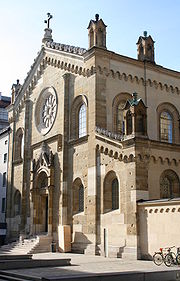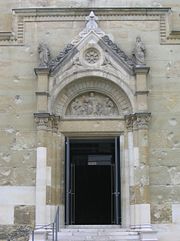
Allerheiligen-Hofkirche
Encyclopedia

All Saints
All Saints' Day , often shortened to All Saints, is a solemnity celebrated on 1 November by parts of Western Christianity, and on the first Sunday after Pentecost in Eastern Christianity, in honour of all the saints, known and unknown...
' Court Church") is a church in the Munich Residence (the royal palace of the Bavarian monarchs) designed by Leo von Klenze
Leo von Klenze
Leo von Klenze was a German neoclassicist architect, painter and writer...
and built between 1826 and 1837. The church was badly damaged from bombing during World War II
World War II
World War II, or the Second World War , was a global conflict lasting from 1939 to 1945, involving most of the world's nations—including all of the great powers—eventually forming two opposing military alliances: the Allies and the Axis...
and for decades remained a ruin before undergoing partial restoration and secularization. It is now used for concerts and events.
History
The Allerheiligen-Hofkirche was commissioned in 1825 by Ludwig I of BavariaLudwig I of Bavaria
Ludwig I was a German king of Bavaria from 1825 until the 1848 revolutions in the German states.-Crown prince:...
, inspired by the Cappella Palatina
Cappella Palatina
The Palatine Chapel is the royal chapel of the Norman kings of Sicily situated on the ground floor at the center of the Palazzo Reale in Palermo, southern Italy....
, the richly decorated Byzantine
Byzantine architecture
Byzantine architecture is the architecture of the Byzantine Empire. The empire gradually emerged as a distinct artistic and cultural entity from what is today referred to as the Roman Empire after AD 330, when the Roman Emperor Constantine moved the capital of the Roman Empire east from Rome to...
royal chapel in Palermo
Palermo
Palermo is a city in Southern Italy, the capital of both the autonomous region of Sicily and the Province of Palermo. The city is noted for its history, culture, architecture and gastronomy, playing an important role throughout much of its existence; it is over 2,700 years old...
, where he had attended Christmas mass in 1823. The commission marked a reversal of the policy of secularisation, carried out under his father Maximilian I at the beginning of the century. Leo von Klenze (1784-1864) produced various designs between 1826 and 1828, using not only the Capella Palatina, but also St Mark's
St Mark's Basilica
The Patriarchal Cathedral Basilica of Saint Mark is the cathedral church of the Roman Catholic Archdiocese of Venice, northern Italy. It is the most famous of the city's churches and one of the best known examples of Byzantine architecture...
in Venice
Venice
Venice is a city in northern Italy which is renowned for the beauty of its setting, its architecture and its artworks. It is the capital of the Veneto region...
as inspiration. Even before a design had been agreed there had been a ceremonial laying of the foundation stone in 1826; and the church was completed and dedicated on October 29, 1837.

Deesis
In Byzantine art, and later Eastern Orthodox art generally, the Deësis or Deisis , is a traditional iconic representation of Christ in Majesty or Christ Pantocrator: enthroned, carrying a book, and flanked by the Virgin Mary and St. John the Baptist, and sometimes other saints and angels...
sculpted in relief is framed by a gothic wimperg
Wimperg
A wimperg is a German and Dutch word for a Gothic ornamental gable with tracery over windows or portals, which were often accompanied with pinnacles. It was a typical element in Gothic Architecture especially in cathedral architecture. Wimpergs often had crockets or other decorative elements in the...
, with statues of Saint Peter
Saint Peter
Saint Peter or Simon Peter was an early Christian leader, who is featured prominently in the New Testament Gospels and the Acts of the Apostles. The son of John or of Jonah and from the village of Bethsaida in the province of Galilee, his brother Andrew was also an apostle...
and Saint Paul
Paul of Tarsus
Paul the Apostle , also known as Saul of Tarsus, is described in the Christian New Testament as one of the most influential early Christian missionaries, with the writings ascribed to him by the church forming a considerable portion of the New Testament...
on either side. Inside, the nave is made up of two domes and an apse
Apse
In architecture, the apse is a semicircular recess covered with a hemispherical vault or semi-dome...
, each separated by an arch of brickwork. These, like the columns that separated the side aisles and supported the gallery, were originally richly ornamented. Heinrich von Hess with various assistants created frescoes on a gold background: the first dome had Old Testament
Old Testament
The Old Testament, of which Christians hold different views, is a Christian term for the religious writings of ancient Israel held sacred and inspired by Christians which overlaps with the 24-book canon of the Masoretic Text of Judaism...
scenes, the second Christ and the apostles, with the four evangelists
Four Evangelists
In Christian tradition the Four Evangelists are Matthew, Mark, Luke, and John, the authors attributed with the creation of the four Gospel accounts in the New Testament that bear the following titles:*Gospel according to Matthew*Gospel according to Mark...
in the four pendentives, and the apse showed the Trinity above a figure of Mary.
On April 25, 1944, bombs destroyed all but the outer walls. The rich interior ornament was almost completely lost. Although other parts of the Residence were restored soon after the war, the ruined church was left to deteriorate for many years. In 1986 the decision was made to restore it. The restoration was completed in 2003, together with the recreation of an enclosed garden, the Kabinettsgarten, on its north side. No attempt was made to recreate the original ornament in the restored building, which instead in its simplicity shows the architectural qualities of Klenze's design. It is now used for concerts and events, within the limits of respecting its former character as a church.
Further reading
- J. H. Biller and H.-P. Rasp, München, Kunst und Kultur, 134-5. Munich: Südwest, 2006. ISBN 978-3-517-06977-7
External links
- Allerheiligen-Hofkirche (Court Church of All Saints), information from the Bayerische Verwaltung der staatlichen Schlösser, Gärten und Seen ("Bavarian Administration of State Palaces, Gardens and Lakes")
- Photo spread of All Saints Court Church / Allerheiligen-Hofkirche

